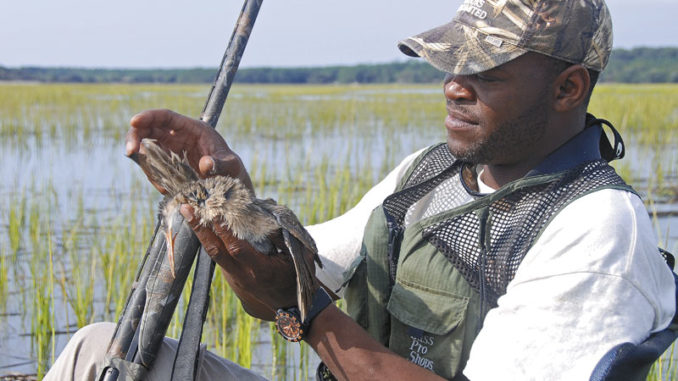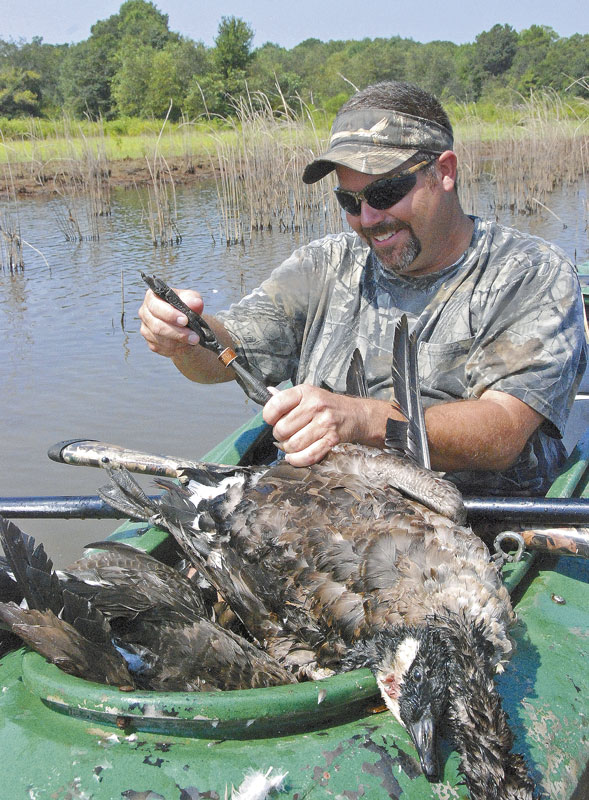
Carolina kayakers, get ready for waterfowl hunting from kayaks
Early waterfowl seasons in both North Carolina and South Carolina allow hunters and paddlers the best of the two sports. Warm weather and water let you hunt in shorts and short sleeves while letting the boat do all the work of transportation and camouflage. Here’s some tips on what to expect for September shooting.
Teal
Pre-season scouting is the key to successful green-winged and blue-winged teal hunting. Teal tend to skirt the edges of grass and points in the marsh. And they’ll often fly over little islands next to those points. A good pass-shooting strategy if you don’t see birds on the water while scouting is to set up in these places and watch to see where birds are going.
Swamps and sloughs with expanses of open water will hold teal, as well as larger lakes and impoundments. Aquatic vegetation in expanses of shallow water is important. Make sure you are hunting an area that has a good food source. You are not likely to see many birds, if any, without food available. Prepared and flooded crop fields have the capacity to produce some great teal shooting.
Hunting in a kayak allows you to be mobile, to go where the birds are. Try to hide the boat in surrounding vegetation rather than installing a blind contraption on your boat. That way, you can bug out quickly and efficiently if needed.
The 2023 early teal season opens Sept. 15 in South Carolina and Sept. 15 in North Carolina. It closes Sept. 30 in South Carolina and Sept. 30 in North Carolina. In the Tarheel State, hunting is open only east of US 17 .
Canada Geese
For everyone else in the Carolinas, there is Canada goose hunting. Over the past several years, early season waterfowlers have discovered the benefits of field hunting for resident Canadas. But this type of hunting can be hit or miss without up-to-the-minute scouting.
Stalking Canada geese is an often-overlooked way to hunt “sky carp” during the mid-day hours when birds are more prone to sit on the water. Stalking often requires you to cover a lot of water on inland lakes. So mother-shipping is a good choice. You can approach from a motorized boat within sight of loafing flocks, perhaps a couple of hundred yards, then deploy the kayak and try to ease within shooting distance.
Swamp Chickens
Marsh hens, rails, moorhens and purple gallinules are collectively known as “swamp chickens.” These birds are best hunted during flood tides so there are fewer places for them to hide. Otherwise, you may hear them but never see one.
Swamp chickens don’t flush like quail or fly like doves. They are not hard to hunt and rank just below oystering in success rate if you find the quarry. Paddling through floating mats of marsh grass is much simpler in a kayak than a motorized boat. The hull slides over and through the vegetation. In this process, birds are often flushed or at least make their presence known by swimming off or making short flight hops.
Check NCWildlife.com and DNR.SC.GOV for hunting seasons and full regulations.
What makes a good hunting kayak?
To understand what kind, style and quality kayak you’ll need for early season waterfowl hunting, it’s important to understand what demands will be made of the vessel.
You will need few to no accessories. That means a boat with mounts, connections and other attachments to the hull won’t be necessary and in fact, may create a hindrance, as hunting kayaks are frequently used to slip through overgrown, swampy, marshy areas with lots of vegetation and woody cover. The best hulls will be narrow and sleek, allowing the paddler/hunter to slip through the cover without hanging up.
The need for stability when hunting from kayaks is probably not as high as in a fishing kayak. The need to stand and shoot doesn’t exist. So it’s better to have a sleeker design over a wider bottom. Hunting kayaks do need the ability to cover a lot of ground, quickly. The best hunting waters may be a mile or more from the launch site, and the hunter/paddler will need to get there before daylight.
Payload is another question. The days of hunting with dozens of decoys are pretty well over. One dozen duck decoys or a half-dozen goose decoys will usually do the trick, if they are needed at all. You read that right. A lot of early season waterfowling will consist of sneaking and pass-shooting, so you may get by in the gear category with nothing but a gun, paddle, call and box of shells.
Is a camouflaged boat a necessity? The answer can be found in the word camouflage, which suggests blending into the surroundings. A dull, drab-colored boat with a beat-up finish certainly meets the definition better than a shiny wrap or high-definition color scheme.
In some cases, the boat may be ditched under some vegetation once you get to the place you want to set up and shoot. But otherwise, comfortable seating will be near the top of the list. A comfortable seat that allows the shooter to move freely and shoot in all directions is also a bonus.





Be the first to comment